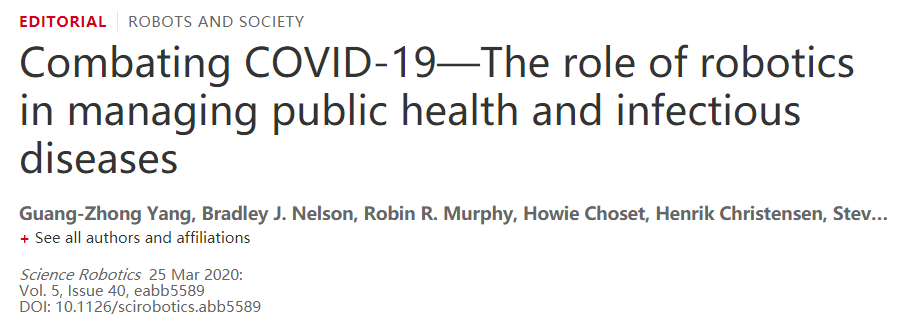


Guang-Zhong Yang from Shanghai Jiaotong University and 12 Other Foreign Scholars Explained the Role of Robotics in Managing Public Health and Infectious Diseases
April 20, 2020
The outbreak of COVID-19 has now become a pandemic. The new coronavirus has affected nearly all continents. South Korea, Iran, Italy, and other European countries have experienced sharp increases in diagnosed cases. Globalization and increasingly interconnected economies mean most countries will be affected by COVID-19. At the same time, the pandemic may drive sustained research in robotics to address risks of infectious diseases.
Guang-Zhong Yang, Dean of the Institute of Medical Robotics, Shanghai Jiao Tong University, along with other 12 foreign scholars, published an online comment “Combating COVID-19--The role of robotics in managing public health and infectious diseases” in Science Robotics, a Science-branded robotics journal, on March 25, 2020. The comment revealed the role of robotics in managing public health and infectious diseases. Full text is summarized as follows:

Robots have the potential to be deployed for disinfection, delivering medications and food, measuring vital signs, and assisting border controls. As epidemics escalate, the potential roles of robotics are becoming increasingly clear. During the 2015 Ebola outbreak, workshops organized by the White House Office of Science and Technology Policy and the National Science Foundation identified three broad areas where robotics can make a difference: clinical care (e.g., telemedicine and decontamination), logistics (e.g., delivery and handling of contaminated waste), and reconnaissance (e.g., monitoring compliance with voluntary quarantines).
In the case of clinical care, areas of specific importance include disease prevention, diagnosis and screening, and patient care and disease management. Robots can monitor high-risk regions and do disinfection on high-touch surfaces with no rest. For diagnosis and screening, mobile robots for temperature measurement in public areas and ports of entry represent a practical use of mature technologies. The risk of staff infection would sharply decrease if robot-assisted nasopharyngeal and oropharyngeal swabbing were applied.
Social robots could relieve the psychological pressure of isolation personnel, which is another challenging area of development. Due to isolation, remote communication is likely to become a new way of human social activities in the future.
Full Text link: